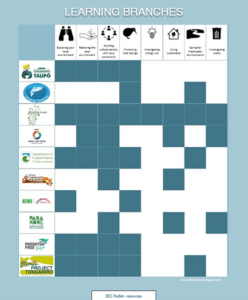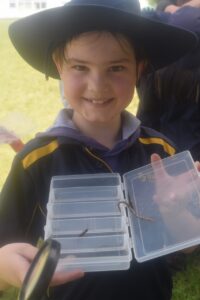On 1st September 2021, I was fortunate to move to Taupō to continue my work as an Environmental Education Facilitator for Enviroschools, having loved this role in Wairoa, northern Te Matau ā Māui (Hawke’s Bay). I hit the ground running thanks to a supportive team and the Taupō Environmental Education Collaborative (Taupō EEC). The model of this collaborative group is the 2nd only in New Zealand. It functions exceptionally well, with a talented and passionate team. The below table illustrates who is involved and what each partner offers.
The Taupō Environmental Education Collaborative was established around the following statements:
-
- Empowering students, teachers & communities to take action for their environment
- Connecting to real-life learning opportunities in your local place
- Incorporating cultural, environmental & societal perspectives
- Developing our rangatahi/youth to be environmental stewards, decision-makers & leaders.
Collaborators bring their own set of skills and passion for Taupō include:
- Kids Greening Taupō
- Department of Conservation
- Taupō District Council
- Enviroschools
- Predator Free Taupō
- Project Tongariro
- Tongariro National Trout Centre
- Garden to Table
- Taupō Community Gardens,
- Taupō Blue Light
- And a partnership between Kiwis for Kiwi, Contact Energy and Wairakei Golf + Sanctuary
Resilient response

Taupō EEC provides an inter-connected approach to local environmental learning and action.
During the Covid pandemic, activities and events were quickly and effectively modified by the collective to suit community requirements. Although Taupō was more fortunate than larger urban areas with restrictions, we never-the-less required a resilient and positive approach to delivering meaningful and action-based support.
In early 2022, with the pandemic still impacting how events and PLD for environment were delivered, we created an informative A2 poster, sharing the intended calendar for the year and contact information. The distribution of the calendar was shared amongst active facilitators. This provided perfect opportunities to approach school principals and explain what is on offer, set meeting dates, hear about intentions, and re-establish kanohi ki te kanohi relationships.
The Enviroschools component of the Taupō EEC has begun to show through. I am seeing that we are each contributing to an understanding of the bigger, inter-connected picture of EEfS (Environmental Education for Sustainability), and schools are reaching into our Enviroschools resources to broaden and deepen what other educators and organisations offer and/or bring to schools.
A network of engagement

Wairakei students explore their gully using a scavenger hunt activity.
Rachel Thompson, leading Kids Greening Taupō, is an exceptionally passionate and driven facilitator. She works alongside many schools (each fortnightly). Rachel leads “Rangers” – developing not only kaitiakitanga attitudes and actions but developing leadership skills. Taupō Enviroschools get extra support through this for their sustainability journeys, as many of the town schools see Rachel fortnightly when she visits her participating schools.
Shannon, Taupō District Council Waste Minimisation, annually conducts a school Waste Audit and follows up about once a term, with support to plan and take action to reduce waste to landfill.
Each visit I make to a school reinforces support, motivation and importance of Learning for Sustainability, Empowered Students, insights into Māori Perspectives, deepening Respect for Diversity of People and Cultures and building resilient Sustainable Communities.
Sustainable Communities

Hands on learning brings smiles.
Alex Daniel was previously Enviroschools facilitator for Taupō and has gathered support and momentum for a similar collaborative model in Kirikiriroa/Hamilton where she continues to facilitate. Sustainable Communities are made of this mutually supportive, networking magic!
The Taupō collective model draws in and supports schools in the district regardless of their stage of and commitment to environmental education – those who have been engaged for many years (such as Wairakei Green-Gold Enviroschools) and Taupō Intermediate (who are showing interest in furthering their engagement).
